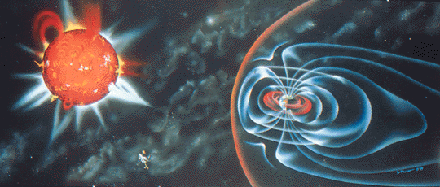![]()
THE PERVASIVE PLASMA STATE
by James Glanz

OUR OASIS, PLANET EARTH, is blanketed by streams of plasma. Solar activity drives an outward plasma
stream known as the solar wind. Some of the charged particles are entrained in the Earth's magnetic field,
forming structures called the radiation belts. [Courtesy of Space Science Institute; illustrator Steve Mercer]
On our planet, we inhabit a calm little oasis of ordinary solids, liquids and gases that is immersed in a perpetually blowing, roiling, flaring, erupting substance of a very different kind, called plasma. Sometimes called the fourth state of matter to distinguish it from its tamer cousins, plasma makes up more than 99 percent of the visible universe by some estimates. The plasma side of the cosmic ledger includes the seething atmospheres and interiors of stars, the wind of particles that our sun flings outward into space, Earth's cocoon-like magnetosphere, the tenuous wasteland between stars and galaxies, and fantastically energetic displays such as quasars, supernovas and parts of the compact spinning stars that spray out beams of x-rays like some kind of hellish fire hose.
When they are artificially produced and bottled up here on Earth, plasmas turn out to be extremely useful. We create plasmas each time we flip on a fluorescent light or a neon sign. Plasmas etch the tiniest circuit features on the microprocessor chips that are at the heart of our desktop computers. Carefully controlled clouds of plasma can "rain," or deposit, thin layers of materials onto surfaces as a crucial step in manufacturing industrial diamonds and superconducting films. Particle accelerators much more compact and powerful than any now in existence could emerge from experiments that are using intense plasma waves to push electrons up to relativistic speeds. Jets of plasma spin and maneuver orbiting satellites. Even without leaving Earth's surface, however, laboratory experiments can shed light on the wider universe of plasma phenomena, as when the shock waves produced by laser beams striking a small speck of plasma help unravel the dynamics of an exploding star.
But no matter how cleverly we try to harness them, plasmas sometimes revert to their unruly nature: Only after decades of research have
INDUCTIVELY COUPLED PLASMA SOURCE is used for plasma etching. Here a semiconductor wafer is placed horizontally on a stage, and the plasma removes material uniformly from the desired regions. [Courtesy of Engineering Research Center for Plasma Aided Manufacturing, University of Wisconsin, Madison; Photographer, Bruce Fritz]
![]()